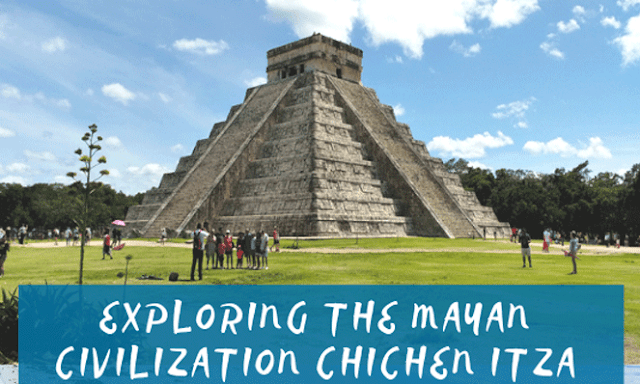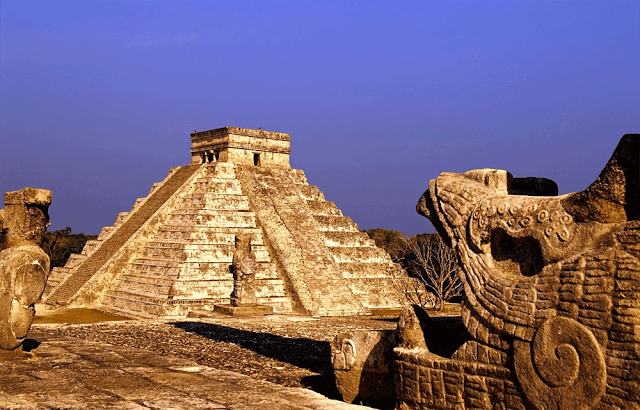The ancient Mayan civilization left many places with interesting architecture, among which is the sacred city of the people of Itza - Chichen Itza, which translates from the language of the local tribes - the “mouth of the wells of the tribe of Itza”, the political and cultural center of the Maya in the north of the Yucatan peninsula (Mexico) -Archeological park, a heavenly place with lots of temples and a large number of ancient relics.
Time of foundation VII. AD, the ruins are conditionally divided into two groups: buildings VI-VII centuries. AD, it relates which to the Mayan culture and X-XI centuries. not the Toltec period. Spanish conquests in the middle of the XVI century the destruction of Chichen-Ice. After 1194, the mysterious city was empty, and it remains unclear what caused the rapid rumination, some scholars suggest that this happened because of the policy of the Spanish conquerors who believed in their Christian duty to burn manuscripts and kill the clergy of the Mayan people.
The main pyramid of the ancient city of Chichen-Itza:
The main pyramid of the ancient city of Chichen-Itza, the ruins of which are still preserved to this day - “Kekulkan Temple” - the “nine-story” pyramid, 24 meters high, has 4 broad stairs on 91 steps on each side. Together with the upper platform in the amount, it gives 365 - the number of days in the year.
It is interesting that only at the day of the spring and autumn equinox (March 20 and September 21) approximately at 3:00 pm, the sun’s rays fall on the grand staircase of the pyramid so that the light and shadow of the railing form the image of seven equidistant triangles interlacing with a bizarre pattern which resembles a snake with a length of 37 meters!
The ancient builders of Chichen-Atha:
In autumn, the “snake” slides in the sun, and in the spring “creeps up.” The illusion of the stone head of the snake at the foot of the pyramid completes. Like many other Mayan monuments, they dedicate this pyramid to one of the supreme gods - Cuculcan (in the Aztecs - Quetzalcoatl), whose symbol was the feathered serpent with the head of the man. Virtually all the oldest cities of Maya are oriented not to the north but later but to the eastward to 15.5 degrees (accident or regularity ...).
The ancient builders of Chichen-Atha found each building in the city extremely precisely, achieving a special acoustic effect in which they amplified even small sounds. Tour guides, standing near the pyramid of Kukulcan, are pleased to show surprise tourists, as a splash in the palm causes an intensified moon on the top of the pyramid.
On the territory of the city, there is a giant well, created by nature striking by its size. Almost round, as if he had drilled a huge spin, he reached a diameter of sixty meters, and still known architectural monuments - “The Temple of Warriors in Chichen-Its” on the low “4-storey” pyramid and “Temple of Jaguars” - both are decorated the wonderful wall paintings, the observatory “Karakol”, 7 “stadiums” for the ball, among them “Great field for Play Ball “is the largest Mayan stadium, 135 meters long! Interesting “A group of thousands of columns”, forming a giant rectangle (for today only the remains of 4 columns).
UNESCO recognizes Chichen Itza:
The main street of the city the way of the dead stretches for 3.5 kilometers. According to scientists, this road should become a terrestrial analog of the Milky Way. And the location of the main attractions resembles the location of the Egyptian pyramids or stars in the belt of Orion, but also deflects the mysterious 15.5 degrees! Why? This mystery still does not rest the scientist. The ancient Mayans of the Indians left many still unsolved mysteries waiting for their Knorozov ...
UNESCO recognizes Chichen Itza as the world’s cultural heritage site and is the second most popular tourist destination for archaeological excavations in Mexico. In 2007, according to survey results, I recognized Maya as one of the new seven wonders of the world.
The ancient builders of Chichen-Atha:
In autumn, the “snake” slides in the sun, and in the spring “creeps up.” The illusion of the stone head of the snake at the foot of the pyramid completes. Like many other Mayan monuments, they dedicate this pyramid to one of the supreme gods - Cuculcan (in the Aztecs - Quetzalcoatl), whose symbol was the feathered serpent with the head of the man. Virtually all the oldest cities of Maya are oriented not to the north but later but to the eastward to 15.5 degrees (accident or regularity ...).
The ancient builders of Chichen-Atha found each building in the city extremely precisely, achieving a special acoustic effect in which they amplified even small sounds. Tour guides, standing near the pyramid of Kukulcan, are pleased to show surprise tourists, as a splash in the palm causes an intensified moon on the top of the pyramid.
On the territory of the city, there is a giant well, created by nature striking by its size. Almost round, as if he had drilled a huge spin, he reached a diameter of sixty meters, and still known architectural monuments - “The Temple of Warriors in Chichen-Its” on the low “4-storey” pyramid and “Temple of Jaguars” - both are decorated the wonderful wall paintings, the observatory “Karakol”, 7 “stadiums” for the ball, among them “Great field for Play Ball “is the largest Mayan stadium, 135 meters long! Interesting “A group of thousands of columns”, forming a giant rectangle (for today only the remains of 4 columns).
UNESCO recognizes Chichen Itza:
The main street of the city the way of the dead stretches for 3.5 kilometers. According to scientists, this road should become a terrestrial analog of the Milky Way. And the location of the main attractions resembles the location of the Egyptian pyramids or stars in the belt of Orion, but also deflects the mysterious 15.5 degrees! Why? This mystery still does not rest the scientist. The ancient Mayans of the Indians left many still unsolved mysteries waiting for their Knorozov ...
UNESCO recognizes Chichen Itza as the world’s cultural heritage site and is the second most popular tourist destination for archaeological excavations in Mexico. In 2007, according to survey results, I recognized Maya as one of the new seven wonders of the world.
- We will download some information about travel traffic, in the Mayan:
- Follow us on this Blog to receive each new
- Leave a comment and share your experience









0 Comments